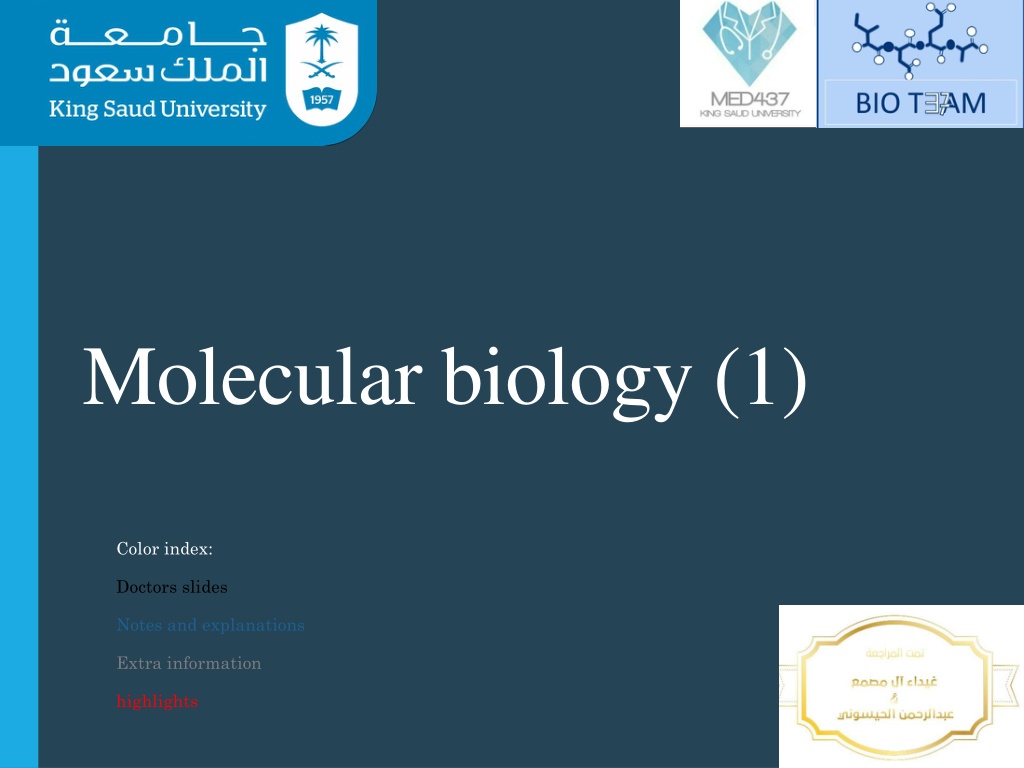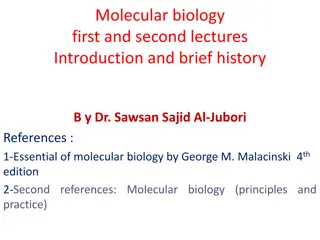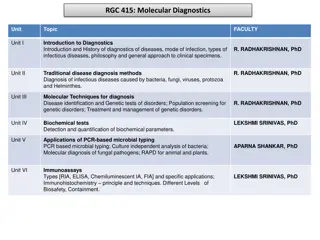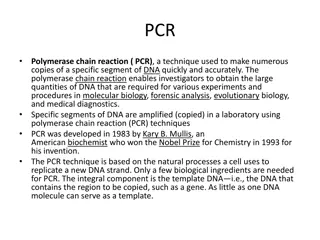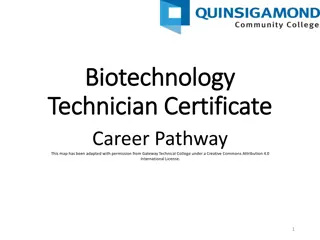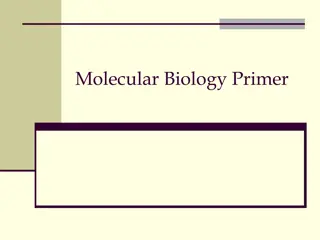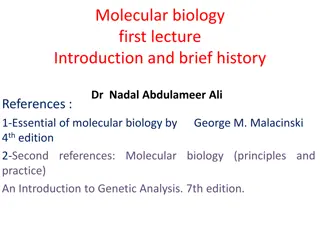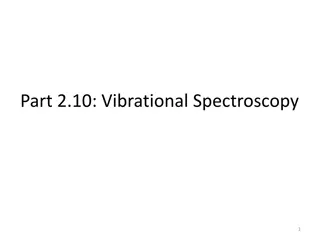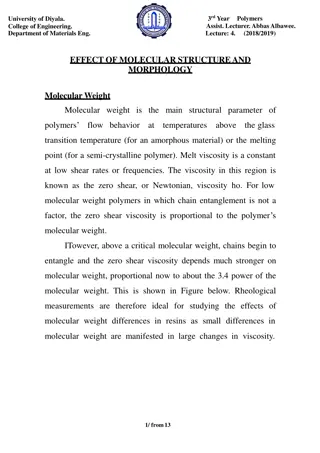Understanding Molecular Biology Basics
Explore the central dogma of molecular biology, focusing on DNA, RNA, and proteins. Learn about nucleic acids, nucleotides, and the chemical structures of DNA and RNA. Understand the role of genes, genetic information flow, and the fundamental components of cellular processes in genetics.
Download Presentation

Please find below an Image/Link to download the presentation.
The content on the website is provided AS IS for your information and personal use only. It may not be sold, licensed, or shared on other websites without obtaining consent from the author. Download presentation by click this link. If you encounter any issues during the download, it is possible that the publisher has removed the file from their server.
E N D
Presentation Transcript
Molecular biology (1) Color index: Doctors slides Notes and explanations Extra information highlights
Know the central dogma of molecular biology. Understand the composition, types and structure of DNA and RNA. Describe the organization of DNA in the chromosome and the role of histone proteins. : Dogma : a principle or set of principles laid down by an authority. (well established fact)
What is central of dogma? is an explanation of the flow of genetic information within a biological system DNA to RNA to protien It involves three components: DNA, RNA and protein. a portion of DNA called a gene is transcribed into RNA then translated into protein. Translated into Transcribed into Human genome contains about 35,000 genes Dr. Review: 1- a gene is inherited from parents to off spring 2-expression of gene defines a person 3-information is expressed as proteins; how? DNA is transcribed to RNA in the nucleus then translated into protein in the cytoplasm.
Nucleic acids. Nucleic acids Is the unit Required for the storage and expression of genetic information. DNA RNA Building blocks of nucleic acids are nucleoside triphosphates (nucleotides). Deoxyribonucleic acid Ribonucleic acid Nucleosides are composed of: nitrogen base + ribose sugar There are two chemically distinct types of nucleic acids: DNA and RNA, which perform several crucial functions. nucleotides are composed of: Nucleoside + phosphate group
Nucleotides Nitrogenou s base: Phosphate groups. sugar Sugar: pentose with 5 carbon ring Purines Pyrimidines Adenine (A) Cytosine (C) Ribose Deoxyribose (with H at C2). Guanine (G) Thymine (T) (with OH at C2). Uracil (U) found in RNA
*No need to memorize structures but know the names.
The sugar carbon numbers are primed (1 2 3 etc.). Nitrogenous base the nitrogenous base atoms are unprimed. So we can know if we are talking about the carbon atoms of the sugar or the nitrogenous base #The nitrogenous base is bonded to C1 of sugar. The PO4 group is bonded to C3 or C5 of sugar.
Chemical structure of DNA & RNA The PO4 bridges the 3 and 5 positions of ribose sugar. PO4 + Pentose sugar = The backbone of DNA structure The linkage between the nucleotides is called phosphodiester bond
Function of nucleotides: Free nucleotides and their derivatives Polymers of nucleotides (as DNA or RNA) perform various metabolic functions not related to genetic information. store and transfer genetic information. e.g. : FAD, NAD, CoA
The double helix DNA The structure of DNA was first determined by James Watson and Francis Crick in 1953. Commonly known as structure. Watson-Crick
Features of Watson-Crick DNA structure Two polynucleotide chains wind or spiral around a common axis (helical axis) to form a double helix. The two strands are anti-parallel (run in opposite direction). One runs from 5 to 3 and the other from 3 to 5. 3 5 5 3 Each strand is a right-handed helix. Polynucleotides chains The nitrogenous bases are in the center of the double helix and the sugar-phosphate chains are on the sides. Opposite to what we have in peptide chain the hydrogen group inside and R chain hanging out.
The surface of the double helix contains 2 grooves: the major and minor grooves. Grooves are the places where protein binds and interact with DNA Each base is hydrogen bonded to a base in the opposite strand to form a base pair (A-T and G-C), known as complementary base pairing. The helix has 10 base pairs (bp) per turn. so, once the helix starts from place and comes back to the same position that include 10 pairs.
Adenine bonds with thymine by double bonds, and Guanine bonds with Cytosine by triple bonds Watson-Crick base pairs Adenine (A) Thymine (T) purine pyrimidine Guanine (G) Cytosine (C) In RNA, Thymine is replaced by Uracil (U)
Types of DNA structure B-DNA(Watson- Crick model ) Right-handed Elongated Wide Narrow A-DNA Z-DNA Direction Helix length Major groove Minor groove Right-handed Short Deep and narrow Wide Left-handed More elongated Not real groove Narrow Zig-zag pattern (nearly perpendicular to the helical axis) 12 Displaced away from the helical axis Centred over the helical axis Placement of bp bp per turn Conformation of deoxyribose 11 10 C3 C2 G (C2) ; C (C3) The carbon where the oxygen is removed major Minor What is the importance of the grooves? Grooves are the sites where the protein binds and Interact.
DNA supercoiling The chromosomes of many bacteria and viruses contain circular DNA which is supercoiled. :
Melting temperature (MT) The temperature at which the double-stranded DNA is separated into two single strands . (Bonding between nitrogenous bases is lost melted and DNA is separated from a double strand to a single strand, if the heat was removed, it will come back to its original state) MT melting temperature of DNA depends on nitrogenous base content (A-T and G-C). A-T has 2 hydrogen bonds,G-C has 3 hydrogen bonds . G-C stronger than A-T. (the more G-C bonds there is the more heat you need to break it) (it works on stabilizing the shape of the molecule) Extra question example: Which one will have higher melting temperature? A) 40A-T bonds , 60G-C bonds B) 20A-T bonds , 80G C bonds (B) because it has more bonds so it needs more energy and heat to melt the bonds
RNA (Types and function) RNA is a single-stranded polymer of ribonucleotides. ( it can fold upon itself ) Types of RNA: mRNA (messenger RNA) Function: Transcription process (from DNA to mRNA). tRNA (transfer RNA) Function: Recognition and transferring. It recognizes amino acids codons and transfers the selected amino acids to the growing protein chain. Structure of a tRNA rRNA (ribosomal RNA) Function: Site of protein synthesis (factory).
How DNA is organized in a chromosome? The human genome contains 3.5 billion base pairs and more than 95% is non- coding or junk DNA. The DNA from single 23 human chromosomes have a length of 1 meter. How such large quantities of DNA are packed into a single cell? ( with the help of proteins called histones ) Each chromosome is a complex of a single linear DNA molecule and protein called chromatin. Chromatin : DNA + Histones 50% of chromatin consists of proteins called histones. Difference between chromosome and chromatin ? DNA exists in Chromatin form in the nucleus. The chromatin condenses to form Chromosomes during cell division To package the long sequence of the genomic DNA, it is highly organized into chromosomes.
Histones chromatin stabilizers Create a complex that the DNA can wrap around Five major types of histones: H1 Holds the wrapped DNA on the complex H2A H2B H3 H4 Histones have positively charged amino acids (arginine and lysine). These proteins bind to negatively charged PO4 groups of DNA to stabilize the chromatin structure.
Nucleosomes Nucleosomes are particles consisting of DNA and histones connected by thin strands of naked DNA (like beads on a string; Sibhah in Arabic). Nucleosomes consist of the histone octamer (eight) and DNA (H2A)2(H2B)2(H3)2(H4)2 H1 binds to 2 complete helical turns of DNA. How DNA is packaged? https://m.youtube.com/watch?v=gbSIBhFwQ4s https://m.youtube.com/watch?v=gbSIBh FwQ4s
MCQs http://highered.mheducation.com/sites/00 72552891/student_view0/chapter7/multip le_choice_quiz.html
GIRLS TEAM: BOYS TEAM: Team leaders: 1- Mohammed hassa hakeem 2- Reham alhalabi 1-Dawood Ismail. 2- turkey al-bnhar 3- saeed alsarar 4- abdulmalik alsharhan Contact us: teambiochem437@gmail.c om For editing file: 5- mohammed al- quefly 437 Biochemistry Team 6- nwaf abdulaziz https://docs.google.com/pr esentation/d/16yNcm2Y08 Cr0Am83lDRfH5NB4F1n g3tdHiB3O1AqMc8
